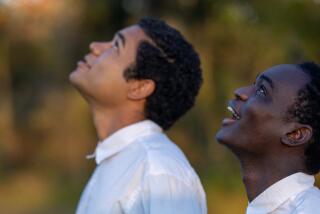Robert Richardson sized up the scenes in ‘Hateful Eight’ and went for the big shot
- Share via
The success of “The Hateful Eight’s” 70-millimeter roadshow may not have reversed the movie industry’s digital conversion trend, but the sold-out multiplex screenings showed there’s still an audience that will turn out to see a film on film. And as a reward, Robert Richardson’s cinematography captured every furtive dart of a gunslinger’s eye, every particle of flying blood and brains in Quentin Tarantino’s violent, epithet-laced chamber piece.
Using Ultra Panavision lenses that hadn’t been touched in nearly 50 years, Richardson shot Minnie’s Haberdashery like a frozen desert, a strip of hostile territory nearly three times as wide as it is high. Eschewing the now-standard digital postproduction fixes, it’s a virtuosic performance as impressive as Samuel L. Jackson’s climactic monologue, in a medium few have the skill or the patience to employ. Richardson details the process of shooting in 65-millimeter and releasing in 70-millimeter, in an interview.
Oscars 2016: Full Coverage | Complete list | Snubs, surprises and reactions | Top nominee photos
The 70-millimeter format is usually associated with spectacle: historical epics, musicals and so on. Most of “The Hateful Eight” takes place in a single room. Why use it here?
I don’t think the format is vital, whether it’s 70 or 35 or 16 or 8. What I do get with 70-millimeter film stock is an extraordinary clarity, that is not an HD clarity. It’s a film clarity that has a softer feel to it overall. If there’s a question mark, it would be “Why did you shoot in 2.76 [aspect ratio]?” rather than “Why did you shoot in 70 millimeter?” That’s an extremely large frame for what ostensibly is an interior movie. Quentin stages and utilizes that frame to allow an audience to know almost precisely where all the characters are at any one time in virtually every shot. I don’t question, “Is it a waste to shoot in 70?” No, I can’t even vaguely see how that’s a criticism I would lay down upon this film.
I think the format is beautiful for actors. We make films with actors. Actors are what keep you attached to the words. It allows you to see with great clarity, to watch their eyes, and the small movements that their faces make, but with a more velvet quality. Being in this format on such a large screen, it’s remarkable. It’s an actor’s format, for certain.
“The Hateful Eight” is about people who can’t trust each other, and shooting with such a wide frame and in such clarity means you’re never sure where to look: If you’re watching the left-hand side of the screen, someone might be going for his gun on the other side.
One of the films that we looked at was “It’s a Mad, Mad, Mad, Mad World.” Quentin had seen it numerous times prior, but once we’d made the determination that yes, we would be able to accomplish this with 70 millimeter and these Ultra Panavision lenses, he began to study it because he noticed that you could get four medium shots in one frame without a problem, and without losing any of the inherent capabilities of the actors. That’s where Quentin went for some of his ideas about staging.
Tarantino also asked you to forgo the use of a digital intermediate, which gives cinematographers enormous control over adjusting shots, and even parts of shots, in postproduction.
There’s so much you can do in the [digital intermediate postproduction]. It’s an integral tool for everybody, in most situations. In this particular case, Quentin asked me not to, as in previous films because he wants as close to the film experience as possible. That was frightening for me because it had been some time since I’d been in a lab, grading a picture, or shooting a picture that you can’t fix [with digital tools] in post. But what an honor to be able to shoot a film on 65 millimeter and be able to release it in 70 millimeter, strictly through chemical. You can do extraordinary levels of DI work, but you’re essentially making a VFX film. That’s not to say that’s wrong, but it’s a different perspective.
So how do you feel about the digital version of “The Hateful Eight” that went into theaters after the 70-millimeter roadshow exclusive was over?
It’s a good-looking [digital cinema package]. It’s relatively true. It just doesn’t have the vibrancy. I just tried to replicate what was exactly on the film. You can’t exactly get there. I can’t get the colors that were as vivid as they were on 70 millimeter.
When you shot “Hugo” for Martin Scorsese, you decided you wanted to use digital for what digital could do, rather than trying to make it look like film. So for you it’s not about prizing one format over another so much as playing to the inherent strengths of each.
I love film, but I’m not opposed to whatever steps that the future is going to bring to us. I don’t feel that we should take HD and say we’re going to turn HD into an emulation of film only. I think there is another use for it, and one that I embrace. Each film requires its own identity.
MORE:
‘Hateful Eight’s’ Quentin Tarantino, Samuel L. Jackson touch raw nerve of racism
‘Hateful Eight’ puts veteran Ennio Morricone’s score center stage
Quentin Tarantino’s guide to ‘The Hateful Eight’ gang
More to Read
From the Oscars to the Emmys.
Get the Envelope newsletter for exclusive awards season coverage, behind-the-scenes stories from the Envelope podcast and columnist Glenn Whipp’s must-read analysis.
You may occasionally receive promotional content from the Los Angeles Times.










